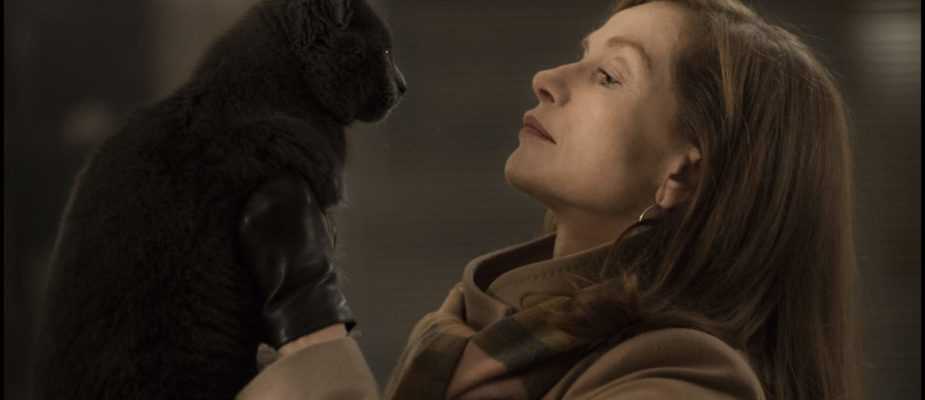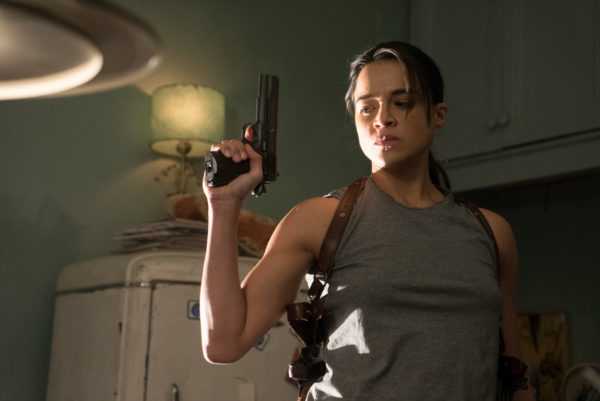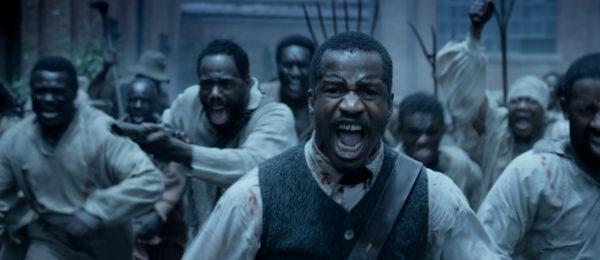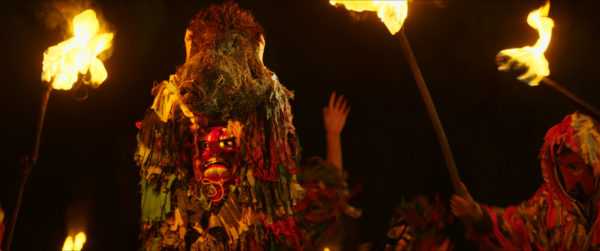French cinema is especially well represented among this year’s better world premieres, with Bertrand Bonello’s Nocturama, Mia Hansen-Løve’s Things to Come, Eugène Green’s Son of Joseph, and Kiyoshi Kurosawa’s Daguerrotype all fine new films by their well-established directors–and in the case of the first two, new career bests as well. Joining both lists is Paul Verhoeven’s enticingly provocative Elle (2016), which received its North American premiere at Toronto at the end of last week. Elle opens with the sounds of a sexual assault even before the director fades in to reveal his lead, the great Isabelle Huppert (The Piano Teacher, Things to Come), pinned beneath her attacker, with her upper body exposed, and her legs covered in blood. Once he leaves, Huppert’s Michèle sweeps up the broken glass and then submerges in her bathtub, where her blood will pool on the water’s sudsy surface. Soon, Michèle returns to her office, which develops graphic, mature-themed video games; there, she will insist, along with her business partner Anna (Anne Consigny, The Diving Bell & the Butterfly), that a new game is not nearly intense enough in its violence–a fact that will lead to the angry incrimination of a male employee, who accordingly will become the first of a set of suspects.
The sexual assault and video-game motif each will be key to understanding Verhoeven’s approach to his latest material, adapted from the 2012 novel Oh… by French writer Philippe Djian. In the case of the former, the assault, the Basic Instinct (1992) and Showgirls (1995) auteur does not ultimately leave the excruciating violence off-screen, despite the opening treatment and the film’s sheen of French bourgeois sophistication in its elegant soft-focus and twinkling score: the sound of her cat’s meow (the crime’s only observer) will force Michèle to relive the incident, this time on screen. Additional attacks will follow, this being a Verhoeven film, with the subsequent crimes operating according to the logic of the video game, where the same or a related violent scenario will continue to replay itself until the attacker is stopped or defeated. The on-screen video-game footage likewise allows for the incorporation of schlock science-fiction content, in the spirit of a Robocop (1987) or Starship Troopers (1997), and for the film’s bottom-shelf special effects. This film might look like Michael Haneke–and even feel like it at times, in all its nasty humanity–but it is anything but in its allegiance to low-brow genre traditions.
Elle, above all perhaps, and in the end, is highly effective suspense-oriented entertainment, beginning with the atmosphere of suspicion that the director creates around Michèle. Along with the female lead, we appraise each of the men in her life as potential suspects, beginning again with her male coworkers again, before Verhoeven reveals the perpetrator (with some time to spare in the story). At this latter juncture, the director’s taste for the salacious and his role as provocateur takes over as his heroine does not entirely manage to sever from her attacker. This is the complex French thriller of quality that only a schlock-master like Verhoeven could make.
Then again, next to Walter Hill’s (re)ASSIGNMENT (2016), Elle might as well be the bourgeois French cinema it sets out to subvert. Embracing the graphic novel (in contrast to Elle’s video game) for its own low-art-form intertext, (re)ASSIGNMENT tells the infinitely absurd story of Frank Kitchen (Michelle Rodriguez), a hit man–with the emphasis on man–who is subjected to an unwanted gender reassignment surgery after he assassinates the brother of disgraced surgeon Rachel Kay (Sigourney Weaver). Rodriguez plays Kitchen both before and after the surgery, with Hill presenting full frontal depictions of both the character’s male and female bodies. When Kitchen discovers her new body in a putrid Tenderloin hotel room (the film’s San Francisco setting is not accidental), she looks at her breasts and genitalia with fear and abject horror; (re)ASSIGNMENT in this respect is almost tailor-made for gender and feminist film theory syllabi–and Society of Cinema and Media Studies academic conference papers. Someone, no doubt, is already putting together a panel.
For her part, Dr. Kay professes a desire, during her evaluation by her psychiatrist (Tony Shalhoub), not only to enact revenge against Kitchen, but also to confirm that Frank’s identity won’t change with his reassignment surgery. Rodriguez’s character, in fact, as both a man and later a woman, will have relations with the same woman–in the latter instance echoing David Lynch’s Mulholland Drive (2001) in blonde-brunette visual contrast of the couple. Throughout, the actress, well cast in the role (and bringing in the extra-textual public knowledge of her bisexuality), very effectively sustains the impression of her male identity, even after she is given her female body, thanks most obviously to her vocal performance, but also (and more successfully) to the uncomfortable manner in which the re-assigned Frank carries himself.
As blunt as the gender discourse of (re)ASSIGNMENT may be, Hill’s film proves overwhelmingly of our moment, in much the same manner that Hard Times (1975) captured the depressed spirit of the mid-1970’s; that The Warriors (1979) and later Trespass (1992) highlighted the urban decay of their period; and Streets of Fire (1984) tapped into apocalyptic sentiment and 1950’s nostalgia of the middle Reagan years. For this reason alone, not to mention for the manic outrageous stylization (evident in every frame) that Hill’s film self-reflexively claims as its ultimate justification, there is a far more interesting argument to be made in favor of (re)ASSIGNMENT than there is a case against it.
Criticism, of course, is a question of values. In arguing for conventionally “trashy” films like Elle and (re)ASSIGNMENT, as I have thus far, I am making an argument not for their sordidness, though this is the most conspicuous quality of each, but rather for their distinctive authorial perspectives, their awareness of narrative and/or generic codes, and for their ability to surprise and shock on a consistent basis. Nate Parker’s The Birth of a Nation (2016), on the other hand, is very different sort of filmmaking, one for which I have little enthusiasm and even fairly strong formal objections, as the reader will soon see–though I will do my best to articulate what distinctiveness it does have.
Loosely presenting the life of Nat Turner (played by the filmmaker Parker, an OU alumnus), a Virginia slave and minister who led a violent rebellion against slaveholders in Southampton County, Virginia in 1831, The Birth of a Nation is conspicuous immediately for the old-fashioned flavor of its audio-visual storytelling, the familiarity of its dialogue, and for the New Testament Christianity that Turner’s pre-rebellion experience seems to bespeak. If anything, The Birth of a Nation begins and remains of a film of faith for the majority of its running time (placing it in a larger context of popular African-American entertainments of which most white viewers are ignorant); then again, when the time comes to begin their fight, an Old Testament Christianity–reminiscent of Mel Gibson’s Braveheart (1995)–replaces a religion of love for the enemy, and the film’s oppressors receive visceral payment for their godless crimes.
It is very easy to imagine Parker’s film connecting with a mass audience, in much the same way again as Gibson’s bloody epics. Where The Birth of a Nation suffers most, however, is in the heavy hand of Parker’s conventional approach–in the way the director tells the story, not the story he tells. Most egregious are those moments in which Parker seeks to make obvious the evils of a system for which there already can be no moral justification. Take for example that occasion when we see a young girl playing with one of her slaves, around whose neck she has placed a rope. Rather than simply including this damning incident, Parker slows down his film stock and ramps up his score to underline the act. Parker, as such, does not seem to trust his audience to understand the extraordinarily simple and obvious evil of the act he shows. Then there is that excruciating moment in which the viewer–along with our surrogate Turner–watches as the film’s cruelest slave-owner knocks out the teeth of one of his slaves, with a metal implement, and then force feeds him through a funnel. Here we are confronted with extreme real-world violence, something certainly justified in the telling of African slavery’s horrific history. What Parker proceeds to do, however, is to recycle this moment, along with the girl-and-a-rope set-piece and others in a mental flashback that serves to explain Turner’s subsequent gruesome actions. Once more, Parker does not trust the viewer to recall and make the obvious link between the on-screen crimes and future violence; no one, I suspect, will fail to understand the wish to fight back, to repay the generations of unthinkable crimes. Yet, Parker feels the need to manipulate and to make the already obvious all the more so.
In closing, The Birth of a Nation should be acknowledged, like (re)ASSIGNMENT, to be another movie of its moment, in this case as a depiction of an African American uprising against the violence perpetrated against their community by white Americans. It is also a clear provocation in its reclamation of the title of D. W. Griffith’s racist 1915 masterpiece. The problem that Parker runs into is that his filmmaking cannot even begin to approach that of the one hundred-one year old picture, which effectively established the grammar for the last century of Hollywood filmmaking. If you’re going to take the name–and I do love the idea, a la The Replacements and Let It Be, which they stole from the Beatles for their third LP, and bettered–your filmmaking needs to feel new, or at least exciting.
Saving the most provocative and accomplished for last, João Pedro Rodrigues’s The Ornithologist (2016) tells the story of Fernando (Paul Hamy), the titular bird-watcher who goes missing while on an expedition along a picturesque fjord in northern Portugal. As we fade in to start the film, Rodrigues–who claims to have wanted to be an ornithologist earlier in life–fills his soundtrack with the songs of the creatures, the gentle ripple of the current, and the clean sound of Fernando pulling his oar through the surface of the water. From the first, the director establishes a contemplative tone as we share the lead’s perspective–at times looking at the animals through his binoculars in a masked frame. In an exceedingly singular gesture, Rodrigues also provides reversal-angles of his soon-to-be-tested hero from the overhead, heavenly perspective of the film’s soaring animal subjects.
Following a kayak accident that leaves Fernando passed out in a small pool of water, he is revived by a pair of young, superstitious Chinese Catholic women who have lost their way on their pilgrimage to Santiago de Compostela. (Rodrigues accordingly includes a series of digital stills to trace their journey.) Desperate for the intervention of St. Anthony of Padua, patron saint of lost things, the sadistic twosome tie up Fernando, leaving him in a contorted, St. Sebastian-style pose as he struggles to free himself–and escape his new captors. He does, but this will lead to a further series of trials and tribulations, with many possessing sexual overtones, across the film’s richly verdant forests. Fernando, as is already quite evident, is traversing a visually rich and deeply unsettling space of myth and metaphor, where he will come to encounter pre-Christian and Latin rituals, and a mute and deaf shepherd named Jesus–all while Fernando is subjected to something vaguely resembling the stations of the cross.
During his above-noted escape from the Chinese pair, Fernando loses his medication, which he continues to receive text reminders from his partner to take. It seems at least plausible, being reminded of the director’s To Die Like a Man (2009), and given their large pink appearance, that this is HIV medication. In any case, Fernando will ultimately discard the bottle, burn off his finger tips, and throw his desecrated ID card into the water as he eliminates any mark of identity. When he re-encounters a dead Jesus, with a gaping hole in his side (in which the lead will slide his fingers), Fernando performs a miracle, bringing Jesus back from the dead–much to the doubt of the latter actor’s other avatar, Thomas. Fernando himself transforms into St. Anthony, even repeating the saint’s words that open the film in quotation. Here, however, it is no longer Hamy in the role, but the director himself in what finally emerges as a deeply personal affirmation of faith fused with newfound romantic companionship; a Pasolini, in the director’s own estimation, for the today’s art cinema.













